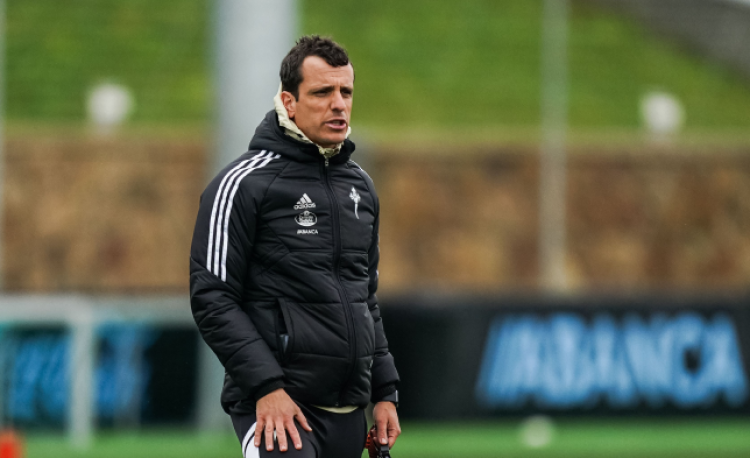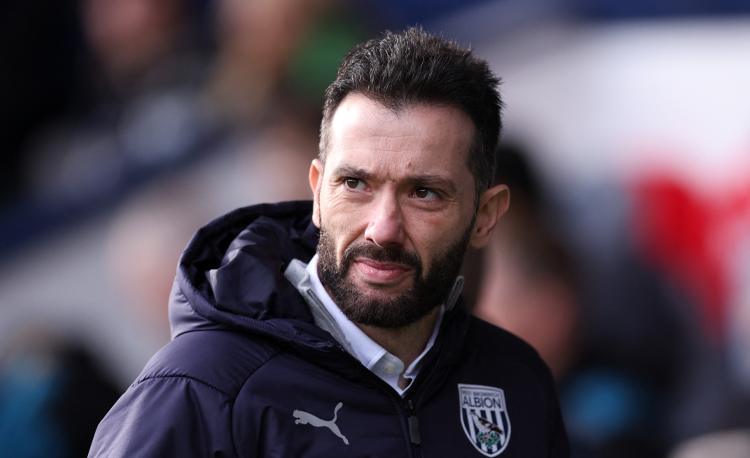You are viewing 1 of your 1 free articles
Beat the press, unlock the block
| Area | Up to full pitch |
| Equipment | Balls, bibs, cones, 2 full size goals |
| No. of Players | Up to 20 players + 2 goalkeepers |
| Session Time | Building up: 8mins Beat the press: 30mins 11v11 game: 18mins |
This is a specific training session that we use to prepare our players in a week when we’re due to face a team that tries to press really high. We want to show our players how to break pressure from the back, so this session is about our build-up play and how to break the opponent’s defensive block.
We focus on the build-up and on the capability to unlock a block or defensive lines against high, intermediate and low pressure.
We can also focus on transitions when we recover the ball, whether that is connecting immediately to the front players or creating conditions to link to the front players after we make some passes to get away from the opponent’s pressure.
We can focus on the transition when we lose the ball, encouraging the players to make a strong reaction to win it back again.
Using this session also allows us to focus on the balance of the team and on taking care of the ball when in possession, and when we’re without the ball we focus on choosing the right moment to press our opponents.
Our game principles are all there and we are creating the need in each player to recognise spaces and see advantages or disadvantages to attack, to defend or to react.
The exercise is continuous – we have the ball, we lose it, we recover it again or not, it’s a game!
To run this session we need the players fresh and recovered, so we would do it on the farthest day from
the last match as possible.
“This exercise is continuous. We have the ball, we lose it, we recover it again or not – it’s a game!”
BUILDING UP
After a warm up [not shown], we set up on a full pitch with a goal and a goalkeeper at each end. We’re using 10 outfield players, set up in a 3-4-3 formation and working together as a team. The team are unopposed except for the opposition keeper and they must use different movements, passes and combinations to work the ball forward to attack the goal.
This first exercise is to create a mental landscape for the players of what we want and need them to do in the next game, with regards to our opponent’s pressure characteristics related to our build up. As a beginning, we show the players some dynamics we would need to disassemble the opponent’s defensive block and we try to give some solutions to our players to allow them to decide what is the best way to break the opposition pressure in the match and allow us to attack the goal.
We give them the starting position each time and ask them to create solutions so the players know where their team mates are on the pitch and therefore can choose the best option to move the ball as if to break the opposition pressure. The player with the ball needs more than one option to choose from as the dynamics are not closed, they are just a starting point to help players recognise the spaces and the time needed to build up from the back to reach the offensive midfield and then attack the goal, whether that’s in three passes or 25 passes. We want to develop criterion to their choices.
For example, in the below diagram the ball starts with the left back and is played around the team until the left back is released down the left wing to receive a pass, as shown [1].
[1]
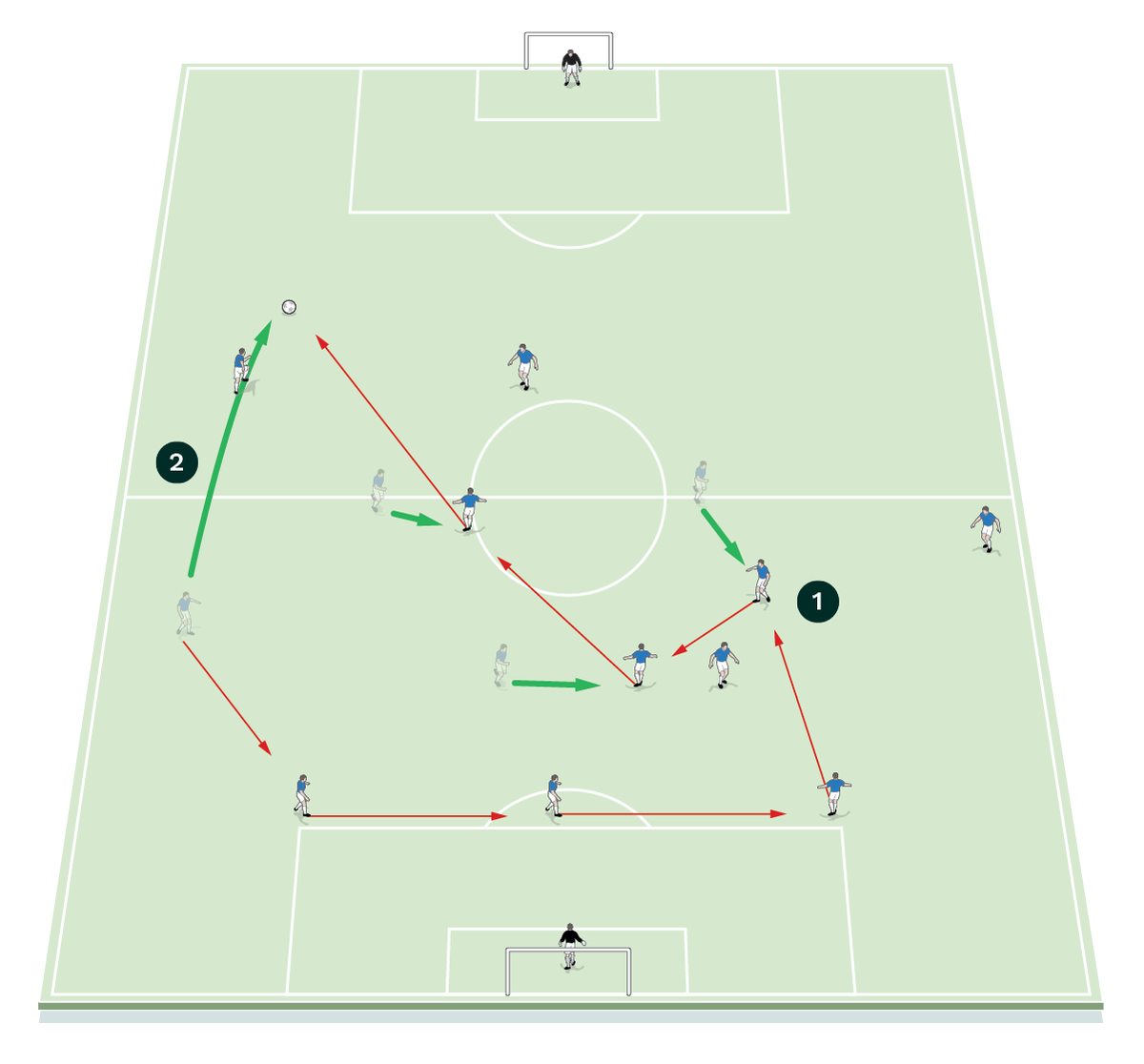
- The team are set up in a 3-4-3 formation and are unopposed except for the opposition keeper. They must use different movements, passes and combinations to work the ball forward to attack the goal
- The coach nominates a starting position each time and asks the players to choose the best option to move the ball, so they must know where their team mates are on the pitch and can choose the best option
The players then launch an attack on the opposition goal. If needed, they can use the help of their keeper to recycle the ball and maintain the passing move.
We set up between the penalty boxes of a pitch coned off to a width of 60 yards with a full size goal and a goalkeeper at each end. A middle zone of 10 yards is also marked out across the centre of the pitch. We’re using 20 outfield players split into two teams of 11 including keepers. The blues are the possession team and are set up with all 11 players in their defensive half ready to play out from the back, while the reds are set up with four defenders in their defensive half and four midfielders and two strikers in their attacking half, ready to press high.
The blue team starts with the ball in their defensive midfield and the aim is to work it through the middle zone and into the attacking half to score in the opposition’s goal. The two red strikers and four red midfielders can press in the blue team’s defensive half as the ball is being played out – effectively making it an 11v6 in that half.
The four red defenders only become active when the blues enter the red team’s defensive half with the ball, while the blue team can only attack in that half with the striker, two attacking midfielders, the left winger, the right back and two players in deeper positions, as shown [2a].
[2a]
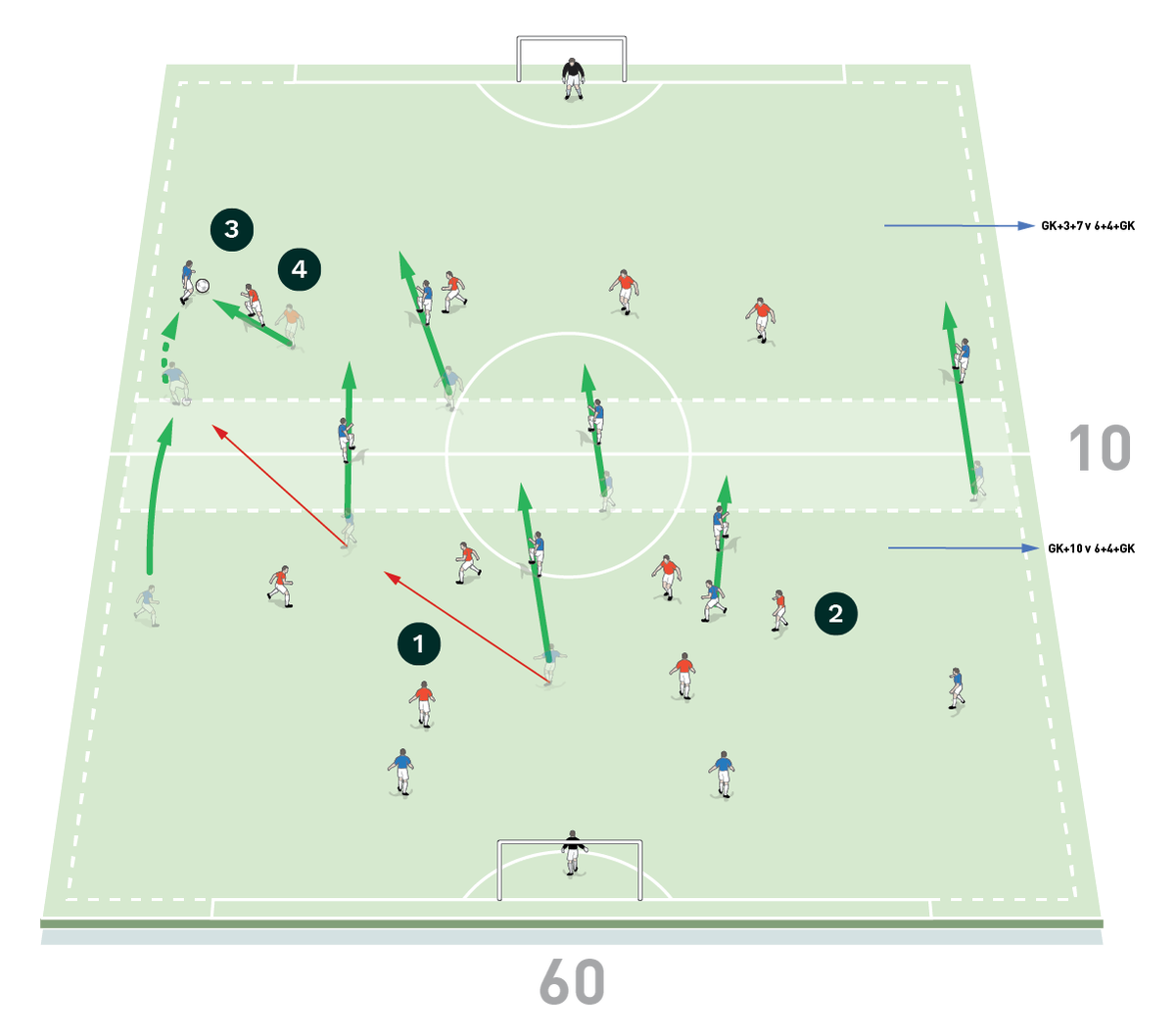
- The blues are the possession team and are set up with all 11 players in their defensive half ready to play out. The coach chooses a different starting position somewhere in the blue team’s defensive midfield each time
- Two red strikers and four red midfielders can press in the blue team’s defensive half as the ball is being played out, making it an 11v6 in that half
- The blues can only attack into the red’s half with the striker, two attacking midfielders, the left winger, the right back and two players in deeper positions
- The four red defenders only become active when the blues enter the red team’s defensive half with the ball
However, if the reds win the ball, they must try to find their offensive midfielders with a pass, creating an attacking transition.
We want to see the blue players using what they learnt in the previous activity and also adding other dynamics to their game that can emerge when they recognise what is going on in time and space during this activity. We run this phase for 8 minutes.
Progression 1: As a progression, when the blues play the ball out from the back, this time we allow a red full back to join the press against them along with the two strikers and four midfielders, effectively making it an 11v7 in the blue team’s defensive half, as shown [2b].
[2b]
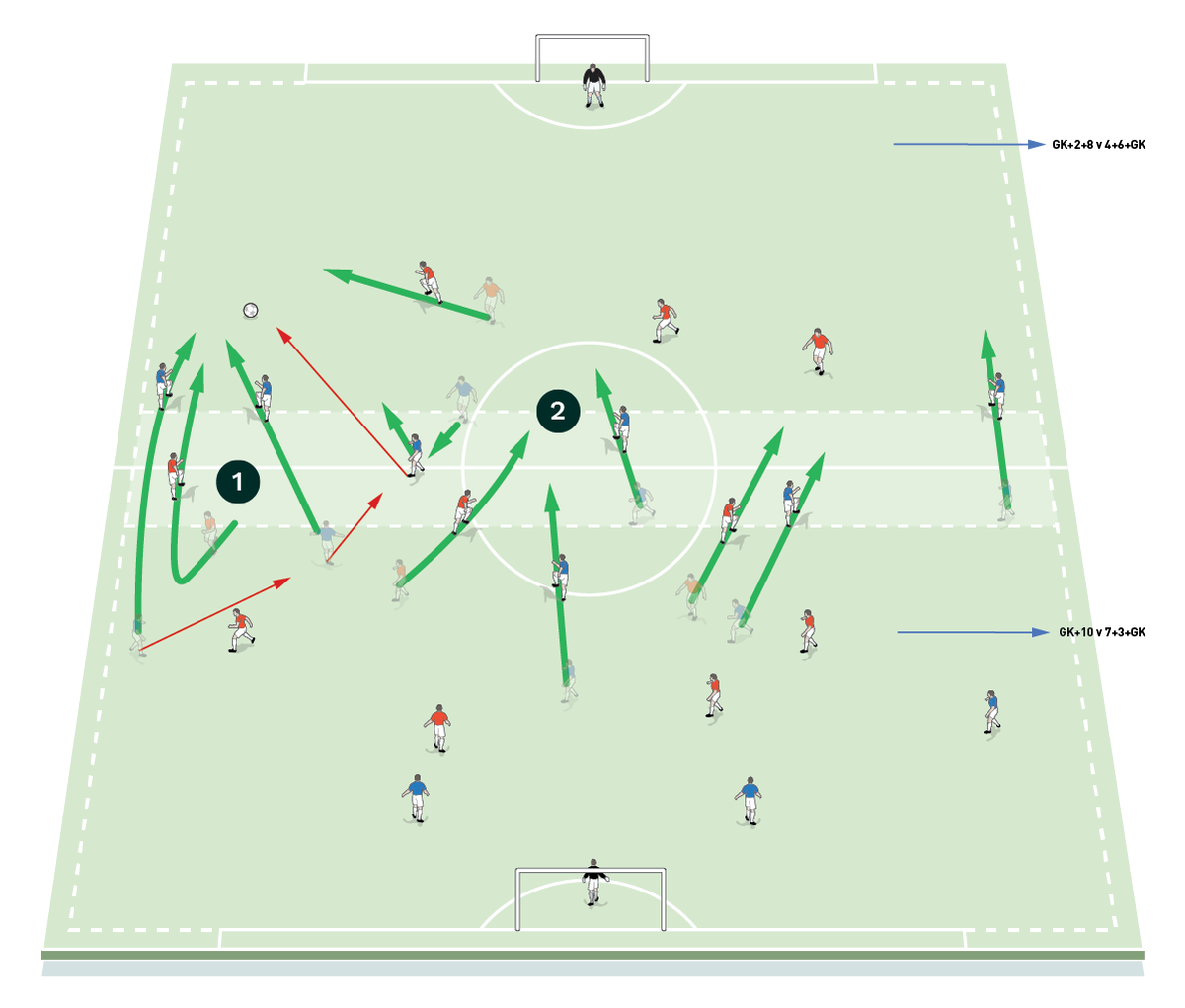
- As a progression, when the blues play out from the back, a red full back is allowed to join the press along with the two red strikers and four red midfielders, making it 11v7 in the blue team’s defensive half
- This time when the blues get the ball across the middle zone, two red midfielders can recover into their defensive half to support the four defenders
This time when the blues get the ball across the middle zone, two red midfielders can recover into their defensive half to support the four defenders. We run this phase for 12 minutes.
“If the red team wins possession of the ball, they must try to find their offensive players with a pass, creating an attacking transition, otherwise, the blue team must react to losing the ball”
Progression 2: As a further progression, we extend the size of the playing area. The goals are moved back 10 yards into the penalty area at each end, level with the penalty spot, and we’re now using the full width of the pitch. Once again the blue team starts with the ball in their defensive half, looking to work it through the middle zone and into the attacking half. Now the red team can press high into the blue team’s defensive half with two strikers, four midfielders and both full backs, effectively making it an 11v8 in that half, as shown [2c].
[2c]
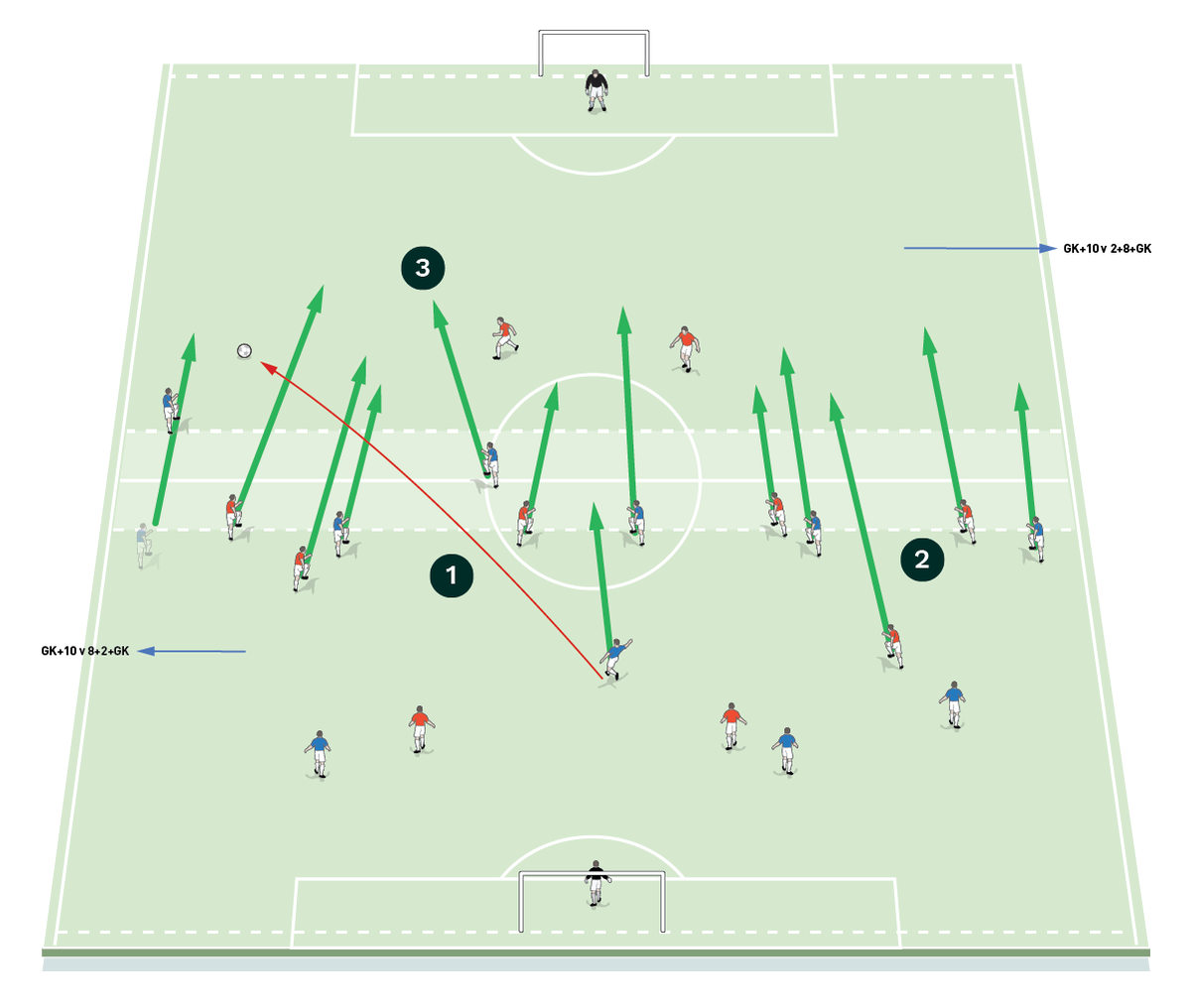
- As a further progression, the size of the playing area is extended. Once again the blue team starts with the ball in their defensive half, looking to work it through the middle zone and into the attacking half
- In this progression the reds can press high with two strikers, four midfielders and now also with both full backs, making it 11v8 in the blue half. But the blues play through the press and here the reds have to recover to defend
- The blues have managed to beat the press and here they attack into the red half in numbers
As the blues are now facing more intense pressure, the blue forwards can drop to support their team mates by offering more passing solutions to beat the opposition’s high press. The blues now have more space on the pitch and they can use this to their advantage to help them move the ball between the players to disconnect the opposition pressure and move forward at the right time. We run this phase for 8 minutes.
Progression 3: Once the blue team reaches the red team’s defensive half, we now allow all four red midfielders to recover into their defensive half to support their defenders. If the red team wins the ball, they must try to find their offensive players with a pass, creating an attacking transition, as shown [2d].
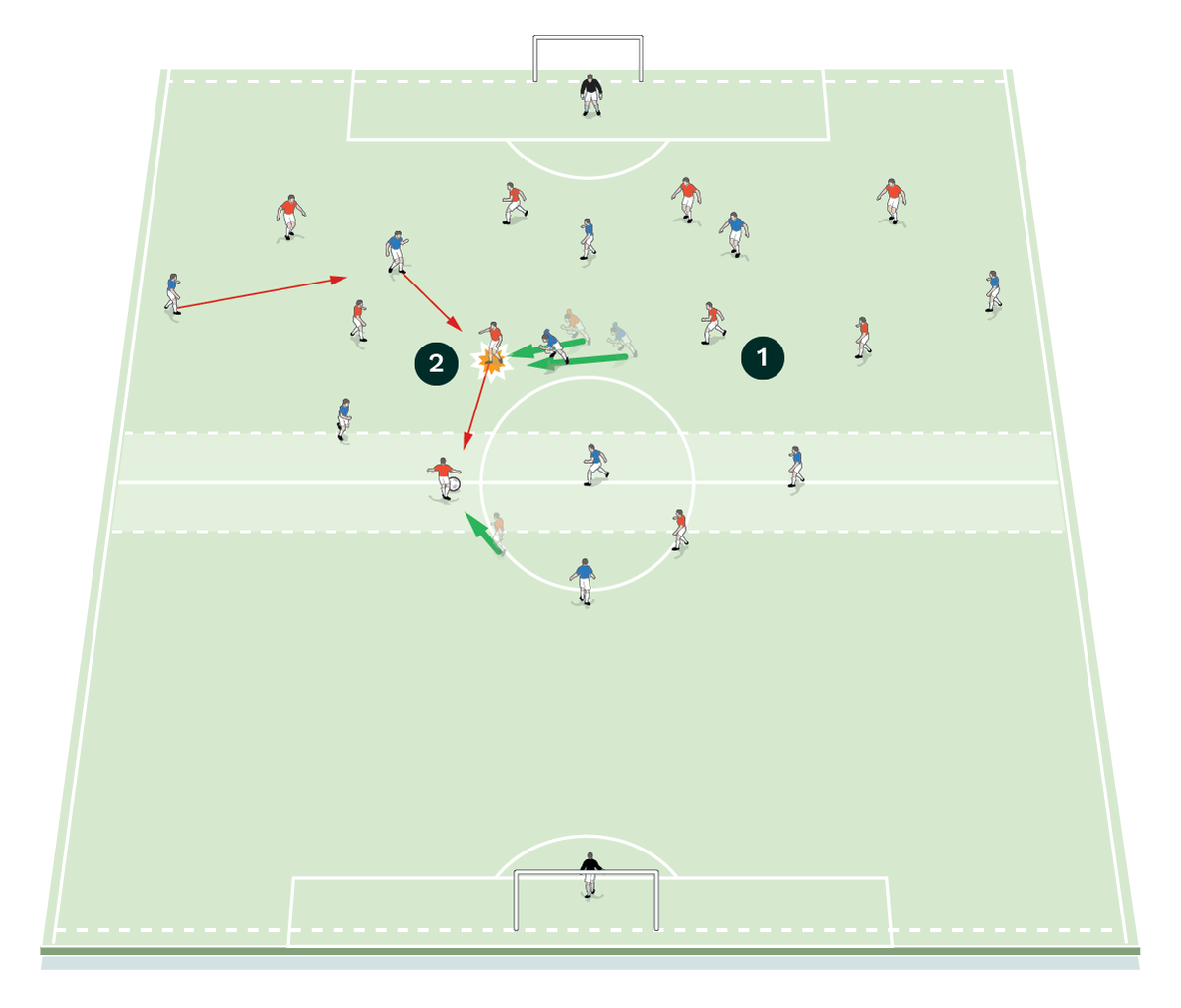
- As a final progression, once the blues cross the middle zone we allow all four red midfielders to recover into the defensive half to support their team mates
- If the red team wins the ball, as they do here, they must try to find their offensive players with a pass, creating an attacking transition
We run this phase for 8 minutes.
After running through the progressions of the activity with the blues acting as the possession team, we repeat them with the reds as the possession team.
11v11 GAME
We set up on a pitch that is coned off at the 18 yard line at one end and we are using the full width of the pitch. A full size goal and goalkeeper are positioned at each end. We are using 20 outfield players split into two full teams of 11 including goalkeepers.
We play an 11v11 game without restrictions or conditions, as shown [3].
[3]

- Play starts and restarts with a pass from the keeper. Here
players utilise what they’ve learnt in the previous activities about building from the back and beating a high opposition block - The player on the ball needs more than one passing option to choose from
- Players should recognise the spaces and the time needed to build up play into the offensive midfield and then attack the opposition goal, whether that’s in three passes or 25 passes. Here the blues recycle the ball
Players should employ the movement and dynamic play rehearsed in the previous practices. We play two games of 8 minutes each.
COACHING POINTS
What are the key things to look out for?
The exercise increases in complexity as it builds. We start with a lower number of pressing opponents and we increase the difficulty to the offensive team, with the opposition always increasing as the session progresses.
If we feel that the players cannot reach the goal, we manipulate the opposition or we maintain the same pressure structure for longer.
The size of the area is also adjusted as the number of pressing players increases, as it help us to manipulate the complexity of the exercise.
What are the typical mistakes players might make and how do I avoid them?
Team balance is very important and players should not lose the connection between the different moments. We need to see players always keeping the team together, not only maintaining a linked play but also allowing us to use different kinds of pass to hurt the opponents. The ability to move the ball in order to disassemble the opponent’s block is important, creating different options for the player with ball and creating holes in the defensive block that can be exploited.
Related Files
Editor's Picks
Using the goalkeeper in build-up play
Pressing principles
Intensive boxes drill with goals
Penetrating the final third
Creating and finishing
My philosophy
Pressing initiation
Compact team movement
Defensive organisation
Coaches' Testimonials

Alan Pardew

Arsène Wenger

Brendan Rodgers

Carlos Carvalhal

José Mourinho

Jürgen Klopp

Pep Guardiola

Roy Hodgson

Sir Alex Ferguson

Steven Gerrard
Related
Coaches' Testimonials

Gerald Kearney, Downtown Las Vegas Soccer Club

Paul Butler, Florida, USA

Rick Shields, Springboro, USA

Tony Green, Pierrefonds Titans, Quebec, Canada
Join the world's leading coaches and managers and discover for yourself one of the best kept secrets in coaching. No other training tool on the planet is written or read by the calibre of names you’ll find in Elite Soccer.
In a recent survey 92% of subscribers said Elite Soccer makes them more confident, 89% said it makes them a more effective coach and 91% said it makes them more inspired.
Get Monthly Inspiration
All the latest techniques and approaches
Since 2010 Elite Soccer has given subscribers exclusive insight into the training ground practices of the world’s best coaches. Published in partnership with the League Managers Association we have unparalleled access to the leading lights in the English leagues, as well as a host of international managers.
Elite Soccer exclusively features sessions written by the coaches themselves. There are no observed sessions and no sessions “in the style of”, just first-hand advice delivered direct to you from the coach.
